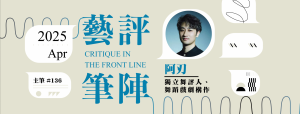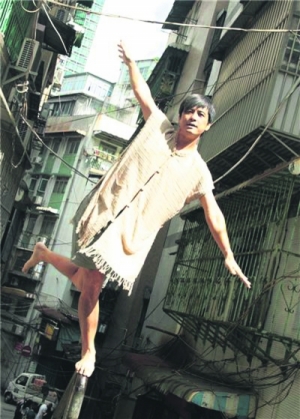Acclaimed pianist Hélène Grimaud had performed Austro-Hungarian repertoires in Hong Kong International Chamber Music Festival 2013. With an interval of two-year, Grimaud had devoted to organise another recital, under the theme of “Water Reflections” for the Hong Kong audience. The programmes this night complied of pieces ranging from Romantic period to contemporary era. Grimaud, dressed in white tangzhuang, performed her music under the spotlight. The light design was poetic, as if highlighting the musical ripples in the middle of a pond.
The opening Wasserklavier (1965) was composed by Luciano Berio as one of the collection in Six Encores. Atypical of the composers’ writing style, this little piece was of tonal idiom. This mystical work, as if a fragmented but logical collage, was carefully assembled by Grimaud. Her fluent and watery articulations ghostly echoed motifs from Brahms’ Op. 117, and Schubert’s Op. 142. The resulting levitated sonority created a dreamy aura that set up the atmosphere of the night.
Rain Tree Sketch II (in memoriam Olivier Messiaen) (1992), the last piano work by Tōru Takemitsu, continued the meditative setting. Grimaud’s precise touching displayed series of organic progressions of chords and lines. One could sense every tiny breath in her phrasings. She accurately executed the rests so to feature the characteristic resonances in this piece. With the careful combination of articulation and pedalling, the resonances fully roared inside the auditorium.
Gabriel Fauré’s Barcarolle No. 5 in F-sharp minor, Op. 66 (1894) swapped the musical scene back to the Romantic period. Grimaud’s extrovert playing presented the constantly roaming materials in an energetic manner. This significantly changed the atmosphere that was set up by the preceding two pieces. Grimaud cleverly took this piece as a bridge between the preceding and succeeding repertoires. This was a good pick as the Barcarolle was somehow daring in its treatment on harmonies, rhythms, and forms.
Ravel’s signature piano piece Jeux d’eau (1901) was then heard. Grimaud’s choice of speed was adventurous, and the overall sonority was atypical of “French” style. As suggested by the title, Jeux d’eau means “play of water” or “fountain”. The poetic name hinted the imagery of water tickling in a joyous manner. Instead of fulfilling one’s expectation towards “French” pianist on French compositions, Grimaud’s interpretation challenged the convention on performing such works. Her articulations on this piece were not particularly light, unlike any French-school pianists’ convention. She seamlessly inputted driving force into the music. As if she transformed the light-hearted tinkling water fountain into a ceaselessly running river; or turned beads of droplets into dashes of splashes. Under her interpretation, one would simply mistake that as a piece by Chopin, or even Liszt. Grimaud’s interpretation on Jeux d’eau, in a sense, was highly personal, unique, and original.
Isaac Albéniz’s Almería from Iberia II (1906) displayed a broad spectrum of timbres throughout the piece. Grimaud well achieved the abrupt changes in speed and texture, where lively exotic dance tunes and slow moving pastoral modal melody were passionately displayed. With her imaginative voices, she had bought the audiences into this musical voyage across various sceneries.
Succeeding the journey, the music returned back to the aquatic theme. Les jeux d'eaux à la Villa d'Este (1877) by Franz Liszt, the source of Ravel’s Jeux d’eau, was a technically demanding piece. As discussed, Grimaud’s interpretation on Jeux d’eau sounded a bit Lisztian. Her musical return to the “original source” was hence a perfect match. The trills in fifth after the opening arpeggios were nicely balanced and evenly articulated. Despite the texture and sonority was somehow thick in general, Grimaud was able to maintain clear melodic lines against the fast-moving figurations. There was no over-romantic treatment throughout this piece. The skilful passages were tackled with ease. The sections were well connected with fluency, marvellously displaying her ability on keeping a smooth musical flow.
The agitated water was then transformed into fogs under Grimaud’s hands, as Leoš Janáček’s In the Mists (I. Andante) (1912) was heard. Her subtle uses of sustaining pedal captured what the title had suggested. The misty timbre was clearly observed in the middle section. The lullaby like ending was approached by light articulation, where downward arpeggios were treated with careful touch. Reaching back to tranquillity, the music led to the last piece of the first half of concert.
Claude Debussy’s La cathédrale engloutie from Préludes, Book I (1910) featured calm sonorities. Despite that, the contrast of dynamics was most prominently heard in this work. Grimaud performed this piece with the most contrasting dynamics. This work depicted the rising and sinking of a sunken cathedral based on Breton mythology. These vivid movements were hinted in its arc-like structure. The “organ chords” passage, located in the middle as the climax, was performed particularly solemn and majestic under Grimaud’s interpretation. Again, the expected French-ness did not emerge anywhere in this piece. Her assertive “organ chords” were powerfully sounded, as if a real organ was roaring its voice in the concert hall. In the last section where Debussy marked “as if an echo of the phrase heard previously” (“Comme un écho de la phrase entendue précédemment”), Grimaud reached it with a deep sonority. Her ripple-like lower notes accompanied the reminiscence of “organ chords,” as if one was hearing the sophisticated echoes of cathedral from the underwater. The “organ chords” ended their journey by echoing the opening gestures, tuning the atmosphere back to tranquillity.
The second half of the recital was allocated for Johannes Brahms’s Sonata No. 2 in F-sharp minor, Op.2 (1852). This piece was the earliest composed work this night, and was written by Brahms at the age of nineteen. The compositional language was unexpectedly mature, and was charged with contrasting emotions and expressions throughout. Doubtlessly, this piece was a dedication to Clara Schumann as one could clearly hear its emotional struggles in the music. The emotional turbulence was well reflected in Grimaud’s fiery interpretation in the energetic first movement. The lonesome second movement featured plenty of call-and-response across different registers. Grimaud highlighted them so to project the sentimental struggles that had been trapped on the score. She displayed these series of self-questioning and answering in a meditative manner, resulting a doubtful atmosphere. This very characteristic feature, as if waves of doubts, resolved into the Scherzo in an attaca manner. Grimaud instantaneously picked up the call-and-response fragments in the beginning bars, leaving no unnecessary pause at that critical point. The tensive Allegro led into a more pastoral sounding poco più moderato section. This section had not managed to resolve the emotional tension built in preceding sections, since it was unsettling in terms of harmony. The opening sostenuto of Finale recalled the lonesome monologue heard in the second movement. Whereas the Allegro non troppo e rubato section, a reminiscence of the first movement, was approached by Grimaud’s great precision in articulations and phrasings. As a whole, the dramatic side of this piece was perfectly approached under her proficient treatment. Her passionate expression had made the inner voices in this sonata fully sounded.
The pieces this night were consistent not only by its thematic elements, but also the historical factors among them. For instance, the opening piece Wasserklaiver recalled Brahms’ compositional language, as one heard in the last piece; the second showcased composer Takemitsu, a largely self-taught composer, drew loads of influence from the second last showcased composer Debussy; and Ravel’s Jeux d’eau mirrored the techniques in Liszt’s Les jeux d'eaux à la Villa d'Este. These carefully planned correlations formed an arc structure among the programmes.
The timbre of the Steinway in Grand Hall is equally balanced across the registers. The lowest register is particularly sweet and harmonious. The pieces were performed in an attaca manner. It was well noted that Grimaud carefully approached the ending notes in each piece. Grimaud, as a Steinway artist, had probably noted that subtlety, and had taken that into consideration for her choices on articulations. It was noted that many of the pieces performed featured the lowest register in the ending. The deepest voices were delicately approached, and together with the gorgeous acoustic design, gave rises to harmonious brimming resonances.
This newly built Grand Hall, as a rising-star of concert hall in Hong Kong, has impressed a lot of performing forces and audiences by its superb acoustic design. Together with the Steinway piano acquired in 2014, it gave excellency particularly in piano recitals. As renowned pianist Angela Hewitt had put, “You have a lovely-sounding hall and an excellent Steinway. It’s perfect for recitals!” Her testimonial was delivered after having her recital last year in the Grand Hall. The Cultural Management Team of HKU had managed to negotiate with as many pianists as possible. The team had so-far invited celebrated pianists like Angela Hewitt, Konstantin Lifschitz, Xiao-mei Zhu, and local pianist Colleen Lee. And upcoming ones are Peter Serkin and Julia Hsu, and Haochen Zhang. We are passionately awaiting to experience more refined performances alike in the Grand Hall.
本網站內一切內容之版權均屬國際演藝評論家協會(香港分會)及原作者所有,未經本會及/或原作者書面同意,不得轉載。










